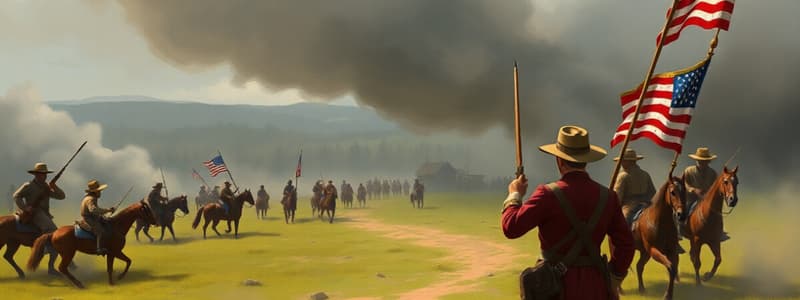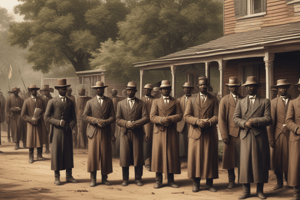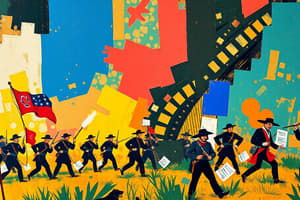Podcast
Questions and Answers
Which of the following were major goals of Congressional/Radical Reconstruction?
Which of the following were major goals of Congressional/Radical Reconstruction?
- Ending slavery
- Punishing rebellious states
- Unifying the country
- All of the above (correct)
According to the document, Johnson's modifications to Lincoln's Reconstruction plan focused primarily on preventing Southern states from rejoining the Union.
According to the document, Johnson's modifications to Lincoln's Reconstruction plan focused primarily on preventing Southern states from rejoining the Union.
False (B)
What were two ways in which former slaves responded to their newly gained freedom?
What were two ways in which former slaves responded to their newly gained freedom?
Marriage, forming groups, and getting pets
The desire to maintain ______ motivated the adoption of Jim Crow laws.
The desire to maintain ______ motivated the adoption of Jim Crow laws.
Match the Reconstruction era amendment with its primary focus.
Match the Reconstruction era amendment with its primary focus.
Who was the leader of the Confederate States of America?
Who was the leader of the Confederate States of America?
The 15th Amendment abolished slavery in the United States.
The 15th Amendment abolished slavery in the United States.
What significant military campaign is known as the March to the Sea?
What significant military campaign is known as the March to the Sea?
The incident known as the New York Draft Riot primarily involved civil unrest in response to ______.
The incident known as the New York Draft Riot primarily involved civil unrest in response to ______.
Match the following events with their significance:
Match the following events with their significance:
Which of the following is NOT a strength of the Union at the start of the Civil War?
Which of the following is NOT a strength of the Union at the start of the Civil War?
What was the Writ of Habeas Corpus?
What was the Writ of Habeas Corpus?
The Copperheads were a political faction in the Union that supported the war effort.
The Copperheads were a political faction in the Union that supported the war effort.
What was the main goal of the Freedmen's Bureau?
What was the main goal of the Freedmen's Bureau?
Which of these laws were designed to limit the rights of freed people?
Which of these laws were designed to limit the rights of freed people?
The Radical Republicans were generally in favor of slavery.
The Radical Republicans were generally in favor of slavery.
The ______ Amendment granted citizenship and equal protection under the law to all persons born or naturalized in the United States.
The ______ Amendment granted citizenship and equal protection under the law to all persons born or naturalized in the United States.
Match each term with its correct definition:
Match each term with its correct definition:
What was the main purpose of the Military Reconstruction Act?
What was the main purpose of the Military Reconstruction Act?
Which group of people were often accused of exploiting the South's economic situation during Reconstruction?
Which group of people were often accused of exploiting the South's economic situation during Reconstruction?
Sharecropping was a fair and equitable system that benefited both landowners and sharecroppers.
Sharecropping was a fair and equitable system that benefited both landowners and sharecroppers.
What significant event, often considered the end of Reconstruction, involved a compromise between the two major political parties?
What significant event, often considered the end of Reconstruction, involved a compromise between the two major political parties?
Jim Crow laws were designed to promote equal rights for all races.
Jim Crow laws were designed to promote equal rights for all races.
Which of the following actions did the Union take during the Civil War to exert control?
Which of the following actions did the Union take during the Civil War to exert control?
The Confederacy primarily controlled its citizens through increased industrial development.
The Confederacy primarily controlled its citizens through increased industrial development.
What role did African Americans play in the Civil War?
What role did African Americans play in the Civil War?
Lincoln's stance on slavery was influenced by the actions of the __________ states.
Lincoln's stance on slavery was influenced by the actions of the __________ states.
Match the following battles with their significance:
Match the following battles with their significance:
Which of the following was a consequence of the Union's victory in the Civil War?
Which of the following was a consequence of the Union's victory in the Civil War?
Citizen reactions to control measures by the Union and Confederacy included riots and desertions.
Citizen reactions to control measures by the Union and Confederacy included riots and desertions.
List one impact of the Civil War on women.
List one impact of the Civil War on women.
Flashcards
Reconstruction
Reconstruction
A period after the American Civil War focused on reuniting the nation and establishing new social and political structures, particularly for formerly enslaved people.
Lincoln's Reconstruction Plan
Lincoln's Reconstruction Plan
Lincoln's plan aimed at quickly reintegrating Confederate states back into the Union by offering pardons to Southerners who swore loyalty to the US and supported the abolition of slavery.
13th, 14th, and 15th Amendments
13th, 14th, and 15th Amendments
Amendments to the US Constitution passed during Reconstruction to abolish slavery, guarantee equal protection under the law, and ensure voting rights for all citizens.
Jim Crow Laws
Jim Crow Laws
Signup and view all the flashcards
Share cropping
Share cropping
Signup and view all the flashcards
Who was Jefferson Davis?
Who was Jefferson Davis?
Signup and view all the flashcards
What was Lincoln's Naval Blockade?
What was Lincoln's Naval Blockade?
Signup and view all the flashcards
What was the Battle of Shiloh?
What was the Battle of Shiloh?
Signup and view all the flashcards
What is the writ of habeas corpus?
What is the writ of habeas corpus?
Signup and view all the flashcards
What was the New York Draft Riot?
What was the New York Draft Riot?
Signup and view all the flashcards
Who were the Copperheads?
Who were the Copperheads?
Signup and view all the flashcards
What did the 15th Amendment do?
What did the 15th Amendment do?
Signup and view all the flashcards
What was the March to the Sea?
What was the March to the Sea?
Signup and view all the flashcards
Union Control Measures
Union Control Measures
Signup and view all the flashcards
Confederate Control Measures
Confederate Control Measures
Signup and view all the flashcards
Border States
Border States
Signup and view all the flashcards
Turning Point Battles
Turning Point Battles
Signup and view all the flashcards
African American Role in the Civil War
African American Role in the Civil War
Signup and view all the flashcards
Causes of Union Victory
Causes of Union Victory
Signup and view all the flashcards
Impact of the Civil War
Impact of the Civil War
Signup and view all the flashcards
Analyze this Document
Analyze this Document
Signup and view all the flashcards
Freedmen's Bureau
Freedmen's Bureau
Signup and view all the flashcards
Black Codes
Black Codes
Signup and view all the flashcards
Radical Republicans
Radical Republicans
Signup and view all the flashcards
14th Amendment
14th Amendment
Signup and view all the flashcards
15th Amendment
15th Amendment
Signup and view all the flashcards
Military Reconstruction Act
Military Reconstruction Act
Signup and view all the flashcards
Scalawags
Scalawags
Signup and view all the flashcards
Carpetbaggers
Carpetbaggers
Signup and view all the flashcards
Civil Rights Cases
Civil Rights Cases
Signup and view all the flashcards
Study Notes
The Civil War
- Key figure: Abraham Lincoln
- Key figure: Jefferson Davis
- The Union had more men and greater industrial power
- The Union had a better transportation system
- The Confederacy had strong military leaders
- The Confederacy had strong support from their population
- The Union strategy was to blockade Southern ports and control the Mississippi River
- The Confederacy focused on defensive warfare and hoped for recognition from European powers
- Major strengths: North — industrial power, population; South — strong military leaders, strong support
- Major weaknesses: North — lack of experienced military leaders; South — limited resources, weaker economy
- Key battles: Antietam, Gettysburg, Vicksburg
- The Emancipation Proclamation was a turning point that emphasized the moral cause of the war, and allowed African Americans to fight
- The Civil War had a huge impact on the economy and lives of Americans; North had more industry and stronger economy, South's economy depended on agriculture, the war destroyed a lot of the workforce and infrastructure
- The war resulted in significant social change, including the abolition of slavery and the beginning of the Civil Rights Movement
- Key outcome: The Union won, ending slavery
Reconstruction
- Key question: What were the main dilemmas of Reconstruction that the federal government needed to resolve?
- Key figures: Ulysses S. Grant, Andrew Johnson
- The 13th Amendment abolished slavery
- The 14th Amendment granted citizenship and equal protection under the law to all persons born or naturalized in the U.S.
- The 15th Amendment prohibited the denial of the right to vote based on race
- Problems included: corruption, economic hardship; violence from white southerners
- The Compromise of 1877 ended Reconstruction
- The impact of Reconstruction on African Americans varied greatly; some benefitted from new opportunities, while others faced continued discrimination
Studying That Suits You
Use AI to generate personalized quizzes and flashcards to suit your learning preferences.




